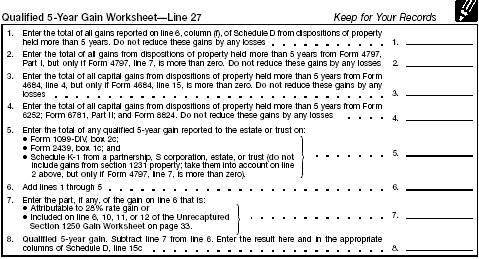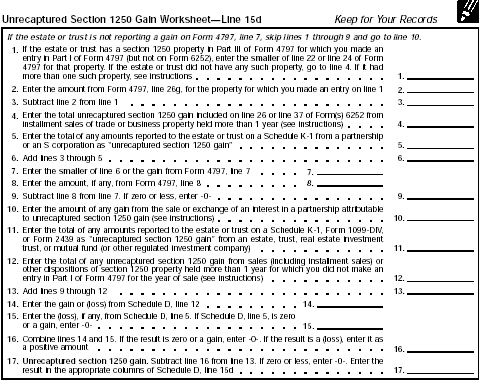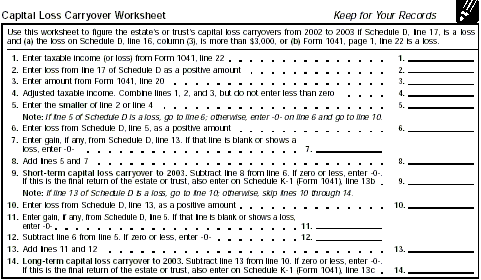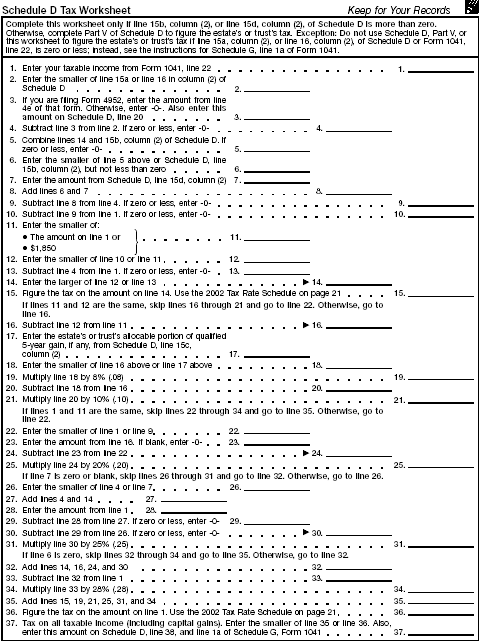Specific Instructions
Lines 1 and 6
Short-term and long-term capital gains and losses. Enter all sales of stocks, bonds, etc.
Redemption of stock to pay death taxes. If stock is redeemed under the provisions of section 303, list and identify it on line 6 and give the name of the decedent and the IRS office where the estate tax or generation-skipping transfer tax return was filed.
If you are reporting capital gain from a lump-sum distribution, see the instructions for Form 4972 for information about the Federal estate tax.
Column (d) - Sales Price
Enter either the gross sales price or the net sales price from the sale. On sales of stocks and bonds, report the gross amount as reported to the estate or trust on Form 1099-B or similar statement. However, if the estate or trust was advised that gross proceeds less commissions and option premiums were reported to the IRS, enter that net amount in column (d).
Column (e) - Cost or Other Basis
Basis of trust property. Generally, the basis of property acquired by gift is the same as the basis in the hands of the donor. If the FMV of the property at the time it was transferred to the trust is less than the transferor's basis, then the FMV is used for determining any loss on disposition.
If the property was transferred to the trust after 1976, and a gift tax was paid under Chapter 12, then increase the donor's basis as follows:
Multiply the amount of the gift tax paid by a fraction, the numerator of which is the net appreciation in value of the gift (defined below), and the denominator of which is the amount of the gift. For this purpose, the net appreciation in value of the gift is the amount by which the FMV of the gift exceeds the donor's adjusted basis.
Basis of decedent's estate property. Generally, the basis of property acquired by a decedent's estate is the FMV of the property at the date of the decedent's death, or the alternate valuation date if the executor elected to use an alternate valuation under section 2032.
See Pub. 551 for a discussion of the valuation of qualified real property under section 2032A.
Basis of assets held on January 1, 2001, where an election to recognize gain was made. If you elected on behalf of an estate or trust to recognize gain on an asset held on January 1, 2001, the basis in the asset is its closing market price or fair market value, whichever applies, on the date of the deemed sale, whether the deemed sale resulted in a gain or an unallowed loss.
Adjustments to basis. Before figuring any gain or loss on the sale, exchange, or other disposition of property owned by the estate or trust, adjustments to the property's basis may be required.
Some items that may increase the basis include:
- Broker's fees and commissions.
- Reinvested dividends that were previously reported as income.
- Reinvested capital gains that were previously reported as income.
- Costs that were capitalized.
- Original issue discount that has been previously included in income.
Some items that may decrease the basis include:
- Nontaxable distributions that consist of return of capital.
- Deductions previously allowed or allowable for depreciation.
- Casualty or theft loss deductions.
See Pub. 551 for additional information.
See section 852(f) for treatment of load charges incurred in acquiring stock in a regulated investment company.
Carryover basis. Carryover basis determined under repealed section 1023 applies to property acquired from a decedent who died after December 31, 1976, and before November 7, 1978, only if the executor elected it on a Form 5970-A, Election of Carryover Basis, that was filed on time.
Column (f) - Gain or (Loss)
Make a separate entry in this column for each transaction reported on lines 1 and 6 and any other lines that apply to the estate or trust. For lines 1 and 6, subtract the amount in column (e) from the amount in column (d). Enter negative amounts in parentheses.
Column (g) - 28% Rate Gain or (Loss)
Enter in column (g) only the amount, if any, from Part II, column (f), that is equal to the amount of the estate's or trust's section 1202 exclusion from the eligible gain on qualified small business stock (see page 30) or from collectibles gains and losses. A collectibles gain or loss is any long-term gain or deductible long-term loss from the sale or exchange of a collectible that is a capital asset.
Collectibles includes works of art, rugs, antiques, metals (such as gold, silver, and platinum bullion), gems, stamps, coins, alcoholic beverages, and certain other tangible property.
Also include gain (but not loss) from the sale or exchange of an interest in a partnership, S corporation, or trust held for more than 1 year and attributable to unrealized appreciation of collectibles. For details, see Regulations section 1.1(h)-1. Also attach the statement required under Regulations section 1.1(h)-1(e).
Lines 2 and 7
Undistributed capital gains. Include on line 7, column (f), the amount from box 1a of Form 2439. This represents the estate's or trust's share of the undistributed long-term capital gains of the regulated investment company (mutual fund) or real estate investment trust.
Include on line 7, column (g), the amount, if any, from box 1b of Form 2439. If there is an amount in box 1c of Form 2439, include that amount on line 5 of the Qualified 5-Year Gain Worksheet on this page if you are required to complete line 15c, column (2) of Schedule D. If there is an amount in box 1d of Form 2439, include that amount on line 11 of the Unrecaptured Section 1250 Gain Worksheet on page 33 if you are required to complete line 15d, column (2) of Schedule D. If there is an amount in box 1e of Form 2439, see Exclusion of Gain on Qualified Small Business Stock (Section 1202) on page 30.
Enter on Form 1041, line 24f, the tax paid as shown in box 2 of Form 2439. Add to the basis of your stock the excess of the amount included in income over the amount of the credit for tax paid. See Pub. 550 for more details.
 The instructions above assume the estate or trust is a cash basis calendar year taxpayer.
The instructions above assume the estate or trust is a cash basis calendar year taxpayer.
Installment sales. If the estate or trust sold property (other than publicly traded stocks or securities) at a gain during the tax year and will receive a payment in a later tax year, you generally report the sale on the installment method and file Form 6252, Installment Sale Income, unless you elect not to do so.
Also, use Form 6252 to report any payment received in 2002 from a sale made in an earlier tax year that was reported on the installment method.
To elect out of the installment method, report the full amount of the gain on a timely filed return (including extensions). If the original return was filed on time, the election may be made on an amended return filed no later than 6 months after the due date of the original return (excluding extensions). Write Filed pursuant to section 301.9100-2 at the top of the amended return, and file it at the same address used for the original Form 1041.
Exchange of like-kind property. Generally, no gain or loss is recognized when property held for productive use in a trade or business or for investment is exchanged solely for property of a like-kind to be held either for productive use in a trade or business or for investment. However, if a trust exchanges like-kind property with a related person (see Related Persons on page 29), and before 2 years after the date of the last transfer that was part of the exchange the related person disposes of the property, or the trust disposes of the property received in exchange from the related person, then the original exchange will not qualify for nonrecognition. See section 1031(f) for exceptions.
Complete and attach Form 8824, Like-Kind Exchanges, to Form 1041 for each exchange.
Line 9 - Capital Gain Distributions
Enter as a long-term capital gain on line 9, column (f), the total capital gain distributions paid during the year, regardless of how long the estate or trust held its investment. This amount is shown in box 2a of Form 1099-DIV. If there is an amount in box 2b of Form 1099-DIV, include that amount on line 9, column (g). If there is an amount in box 2c, include that amount on line 5 of the Qualified 5-Year Gain Worksheet on page 32 if you are required to complete line 15c, column (2) of Schedule D. If there is an amount in box 2d, include that amount on line 11 of the Unrecaptured Section 1250 Gain Worksheet on page 33 if you are required to complete line 15d, column (2) of Schedule D. If there is an amount in box 2e, see Exclusion of Gain on Qualified Small Business (QSB) Stock on page 30.
 The instructions above assume the estate or trust is a cash basis calendar year taxpayer.
The instructions above assume the estate or trust is a cash basis calendar year taxpayer.
Line 14, Column (1) - Beneficiaries' Net Short-Term Capital Gain or Loss
Enter the amount of net short-term capital gain or loss allocable to the beneficiary or beneficiaries. Except in the final year, include only those short-term capital losses that are taken into account in determining the amount of gain from the sale or exchange of capital assets that is paid, credited, or required to be distributed to any beneficiary during the tax year. See Regulations section 1.643(a)-3 for more information about allocation of capital gains and losses.
Except in the final year, if the losses from the sale or exchange of capital assets are more than the gains, all of the losses must be allocated to the estate or trust and none are allocated to the beneficiaries.
Line 14, Column (2) - Estate's or Trust's Net Short-Term Capital Gain or Loss
Enter the amount of the net short-term capital gain or loss allocable to the estate or trust. Include any capital gain paid or permanently set aside for a charitable purpose specified in section 642(c).
Line 14, Column (3) - Total
Enter the total of the amounts entered in columns (1) and (2). The amount in column (3) should be the same as the amount on line 5.
Line 15 - Net Long-Term Capital Gain or Loss
Allocate the net long-term capital gain or loss on line 15 in the same manner as the net short-term capital gain or loss on line 14. However, do not take the section 1202 exclusion on gain from the sale or exchange of qualified small business stock into account when figuring net long-term capital gain or loss allocable to the beneficiaries.
Line 15c - Qualified 5-Year Gain

qualified 5-year gain worksheet
Qualified 5-year gain is long-term capital gain (other than 28% rate gain or gain on lines 6 and 10 through 12 of the Unrecaptured Section 1250 Gain Worksheet) from the sale or other disposition of property held more than 5 years. Qualified 5-year gain is taxed at 8% to the extent the gain would otherwise be taxed at 10%. To figure qualified 5-year gain, complete the worksheet on page 32 if any of the following apply to the estate or trust for the 2002 tax year.
- The estate or trust sold or otherwise disposed of property at a gain that it had held for more than 5 years.
- The estate or trust received a Schedule K-1 from an estate, trust, partnership, or S corporation that reports qualified 5-year gain.
- The estate or trust received a Form 1099-DIV (or Form 2439) with qualified 5-year gain reported in box 2c (box 1c of Form 2439).
- The estate or trust received payments from an installment sale of property that it had held for more than 5 years when it entered into the installment sale.
Line 15d - Unrecaptured Section 1250 Gain
Complete the worksheet on this page if any of the following apply.
- During the tax year, the estate or trust sold or otherwise disposed of section 1250 property (generally, real property that was depreciated) held more than 1 year.
- The estate or trust received installment payments during the tax year for section 1250 property held more than 1 year for which it is reporting gain on the installment method.
- The estate or trust received a Schedule K-1 from an estate or trust, partnership, or S corporation that shows unrecaptured section 1250 gain reportable for the tax year.
- The estate or trust received a Form 1099-DIV or Form 2439 from a real estate investment trust or regulated investment company (including a mutual fund) that reports unrecaptured section 1250 gain for the tax year.
- The estate or trust reported a long-term capital gain from the sale or exchange of an interest in a partnership that owned section 1250 property.

unrecaptured section 1250 gain worksheet
Instructions for the Unrecaptured Section 1250 Gain Worksheet
Lines 1 through 3. If the estate or trust had more than one property described on line 1, complete lines 1 through 3 for each property on a separate worksheet. Enter the total of the line 3 amounts for all properties on line 3 and go to line 4.
Line 4. To figure the amount to enter on line 4, follow the steps below for each installment sale of trade or business property held more than 1 year.
Step 1. Figure the smaller of (a) the depreciation allowed or allowable or (b) the total gain for the sale. This is the smaller of line 22 or line 24 of the 2002 Form 4797 (or the comparable lines of Form 4797 for the year of sale) for that property.
Step 2. Reduce the amount figured in step 1 by any section 1250 ordinary income recapture for the sale. This is the amount from line 26g of the 2002 Form 4797 (or the comparable line of Form 4797 for the year of sale) for that property. The result is the total unrecaptured section 1250 gain that must be allocated to the installment payments received from the sale.
Step 3. Generally, the amount of section 1231 gain on each installment payment is treated as unrecaptured section 1250 gain until the total unrecaptured section 1250 gain figured in step 2 has been used in full. Figure the amount of gain treated as unrecaptured section 1250 gain for installment payments received during the tax year, as the smaller of (a) the amount from line 26 or line 37 of the 2002 Form 6252, whichever applies, or (b) the amount of unrecaptured section 1250 gain remaining to be reported. This amount is generally the total unrecaptured section 1250 gain for the sale reduced by all gain reported in prior years (excluding section 1250 ordinary income recapture). However, if you chose not to treat all of the gain from payments received after May 6, 1997, and before August 24, 1999, as unrecaptured section 1250 gain, use only the amount you chose to treat as unrecaptured section 1250 gain for those payments to reduce the total unrecaptured section 1250 gain remaining to be reported for the sale. Include this amount on line 4.
Line 10. Include on line 10 the estate's or trust's share of the partnership's unrecaptured section 1250 gain that would result if the partnership had transferred all of its section 1250 property in a fully taxable transaction immediately before the estate or trust sold or exchanged its interest in that partnership. If the estate or trust recognized less than all of the realized gain, the partnership will be treated as having transferred only a proportionate amount of each section 1250 property.
Line 12. An example of an amount to include on line 12 is unrecaptured section 1250 gain from the sale of a vacation home previously used as a rental property but converted to personal use prior to the sale. To figure the amount to enter on line 12, follow the applicable instructions below.
Installment sales. To figure the amount to include on line 12, follow the steps below for each installment sale of property held more than 1 year for which you did not make an entry in Part I of Form 4797 for the year of sale.
- Step 1. Figure the smaller of (a) the depreciation allowed or allowable or (b) the total gain for the sale. This is the smaller of line 22 or line 24 of the 2002 Form 4797 (or comparable lines of Form 4797 for the year of sale) for that property.
- Step 2. Reduce the amount figured in step 1 by any section 1250 ordinary income recapture for the sale. This is the amount from line 26g of the 2002 Form 4797 (or the comparable line of Form 4797 for the year of sale) for that property. The result is the total unrecaptured section 1250 gain that must be allocated to the installment payments received from the sale.
- Step 3. Generally, the amount of capital gain on each installment payment is treated as unrecaptured section 1250 gain until the total unrecaptured section 1250 gain figured in step 2 has been used in full. Figure the amount of gain treated as unrecaptured section 1250 gain for installment payments received during the tax year, as the smaller of (a) the amount from line 26 or line 37 of the 2002 Form 6252, whichever applies, or (b) the amount of unrecaptured section 1250 gain remaining to be reported. This amount is generally the total unrecaptured section 1250 gain for the sale reduced by all gain reported in prior years (excluding section 1250 ordinary income recapture). However, if you chose not to treat all of the gain from payments received after May 6, 1997, and before August 24, 1999, as unrecaptured section 1250 gain, use only the amount you chose to treat as unrecaptured section 1250 gain for those payments to reduce the total unrecaptured section 1250 gain remaining to be reported for the sale. Include this amount on line 12.

Capital Loss Carryover Worksheet
Other sales or dispositions of section 1250 property. For each sale of property held more than 1 year (for which an entry was not made in Part I of Form 4797), figure the smaller of (a) the depreciation allowed or allowable or (b) the total gain for the sale. This is the smaller of line 22 or line 24 of Form 4797 for that property. Next, reduce that amount by any section 1250 ordinary income recapture for the sale. This is the amount from line 26g of Form 4797 for that property. The result is the total unrecaptured section 1250 gain for the sale. Include this amount on line 12.
Part IV - Capital Loss Limitation
If the sum of all the capital losses is more than the sum of all the capital gains, then these capital losses are allowed as a deduction only to the extent of the smaller of the net loss or $3,000.
For any year (including the final year) in which capital losses exceed capital gains, the estate or trust may have a capital loss carryover. Use the Capital Loss Carryover Worksheet on page 34 to figure any capital loss carryover. A capital loss carryover may be carried forward indefinitely. Capital losses keep their character as either short-term or long-term when carried over to the following year.
Part V - Tax Computation Using Maximum Capital Gains Rates
Line 21
If the estate or trust received capital gains that were derived from income in respect of a decedent, and a section 691(c)(4) deduction was claimed, then line 21 must be reduced by the portion of the section 691(c)(4) deduction claimed on Form 1041, page 1, line 19.
Line 38
If the tax using the maximum capital gains rates is less than the regular tax, enter the amount from line 38 on line 1a of Schedule G, Form 1041, and check the Schedule D box.

Schedule D Tax Worksheet
Previous| First | Next
Instructions Index | 2002 Tax Help Archives | Tax Help Archives | Home
